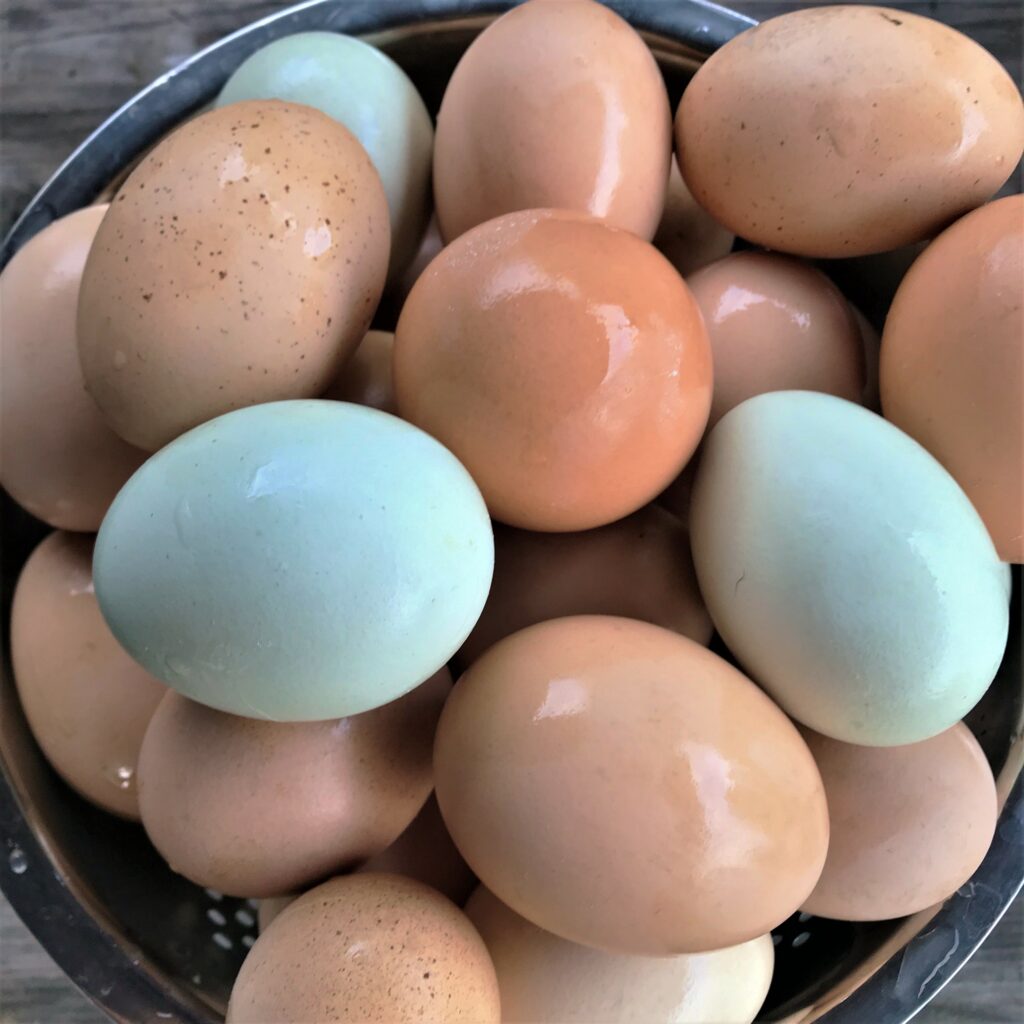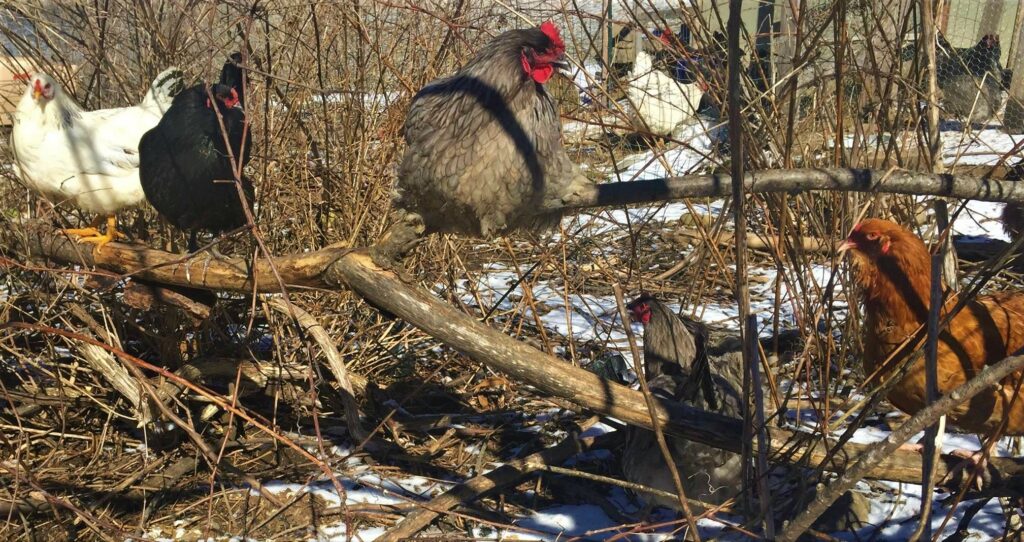Keeping chickens in the summer is one of the most quintessential, charming, and memorable experiences – hens laying a bounty of eggs, your flock free ranging on a warm sunny afternoon, scratching at the earth, and hunting bugs. Chores are often quick and simple, and it’s a pleasant and rewarding experience to spend time with your feathered friends.
Yea… fast forward six months, and it’s now the dead of winter, there’s a foot of snow on the ground, your water is frozen solid, eggs cracked, and your flock is miserable and refusing to step outside into the cold. It’s winter, and if you’re lucky enough to live where it gets cold, or cold and snow, this is a reality that you’ll face.
Keeping chickens in the winter can add some challenges, but it doesn’t need to be a dreaded experience. In fact, I love going out to tend to my flock in the winter. It gives me something to look forward to after a long day of work and a reason to get out of my house! Being cooped up isn’t good for man or chickens.
Keep reading to learn about the do’s and don’ts of keeping happy, healthy chickens during the seemingly long and unending winter months.

Keeping Your Flock Warm – Heating the Coop in the Winter
First and foremost, I want to stress – do not, I repeat, do not heat your coop. I know when it’s cold, your instinct is to hunker down and seek warmth. It’s only natural that you’d want a warm and cozy place for your flock. Chickens don’t need the heat, and you’re asking for trouble (and possibly disaster) when you heat your coop.
We live in upstate NY, where winter is seemingly very long and oftentimes cold, cold, and did I mention cold? It’s not uncommon to have temperatures that are below 0°F, and even stretches in the negatives! We typically experience at least one week in the winter where we are lucky if the daytime temperatures raise above 0°F and the thermometer seems to stall in the single digits. Even with the brutally cold weather and snow our flock does extremely well in the winter.
When it’s cold, your birds will huddle together and fluff their feather for warmth. A wide roosting bar, dry litter, and a well ventilated and draft free coop is your best protection against the cold and snow. Your birds know the best ways to stay warm and will do well with very little human involvement.
When you introduce a heating source in your coop you run the risk of fire, not to mention the possibility of an unintended catastrophe if you were to lose power or your heat source! Chickens that have a heat source are not allowed to gradually get used to the cold, and a sudden loss of power can spell devastating and even deadly consequences for your flock.
Housing
A dry, draft-free, ventilated, and clean coop, with a roosting bar is all your chickens need. Your coop doesn’t need to be fancy or elaborate. A wide roost (a 2×4 placed on the wide side works well), that is placed at least 2 – 3 feet above the ground will give your birds a way to get off of the cold ground and the opportunity to keep warm.
We recommend plenty of litter on the coop floor – it’ll help to keep the coop drier and cleaner and give your hens something to scratch in and search through. We prefer to use a thick layer of wood shavings; they don’t mat down and are easy to clean in the spring.

As a boredom buster, and way to have the chickens work for us turning over their bedding, we scatter a few handfuls of cracked corn and oats onto the coop floor/litter. The chickens will gladly turn over the bedding as they scratch and hunt for their tasty treats.
Feeding your Flock in the Winter
In our coop we have a 40lb hanging feeder, it ensures that our flock has access to high quality feed at all times. If your flock free ranges in the warmer months, or has access to pasture and greens, you’ll notice a sharp increase in feed consumption during the colder months. It’s not uncommon for your feed consumption to jump by 25% or even 50%!
During the cooler fall and winter months, we use a high-quality and balanced layer feed. We are fortunate to have a local grain mill nearby where we purchase our feed from. In addition to the layer pellets we supplement with cracked corn and oats. It provides our chickens with some entertainment in the evening, when they go about scratching and pecking to find the tasty morsels, but also adds additional carbohydrates to keep them warm at night. When the chickens eat and digest the corn, their digestive tract gets to work and produces heat, this helps your hen stay warm throughout the night.
Another important feed element is grit. When the ground is frozen, or covered in a thick layer of snow, your birds won’t be able to scratch and peck at the ground. Since chickens don’t have teeth, they depend on storing grit and small stones in their crop. The grit is what they use to break down and grind their food, it helps to ensure proper digestion. A small container of grit where your birds can self-regulate will ensure that your hens are happy and healthy.
Water in the Winter
Water is another story, and it isn’t always as easy as filling up a feeder with grain. However, it’s incredibly important that your flock has access to clean water throughout the day. You may notice that your flocks average water consumption decreases during the cooler months, this is normal, and isn’t a sign that something is wrong.
I’m going to be honest with you, trudging through the snow, lugging containers of water in the dead of winter isn’t fun, but it is crucial that your birds have access to water. Chickens will drink small amounts of water throughout the day, another reason to ensure they have access to water at all times.
Our current coop has a heated water bucket – this prevents the water from freezing in all but the coldest winter weather. This solution works well for us and our flock has access to water at all times.
However, we didn’t always have electricity in our coop, and a heated bucket or heated water fount isn’t feasible for everyone. So, what can you do if you don’t have access to a heated waterer? For starters, hauling water will be in your future, and oftentimes twice a day when the temperatures plunge far below freezing. We recommend using a rubber pan or the two-bucket method.
- Rubber feed pans are an excellent solution – they don’t crack due to the cold or freezing weather and you can easily turn them upside down outside of the coop to dump out the ice. If they are frozen solid, no worries, you can flip them upside down and stomp on the back with your foot to knock out the ice.
- Two-bucket method – use a pan or small bucket that won’t readily crack or break due to the cold or ice. All you need to do is bring down a bucket of fresh water and bring your frozen bucket in to an area that is above freezing (house, garage, mudroom, etc.). This allows the ice to melt, top off with fresh water, and clean as needed.
Eggs

When the temperature starts to drop below freezing, we try (emphasis on try) and take several trips to the coop to collect eggs. On days where we’re only able to make it out once during the day (and this happens more often than not) were apt to find frozen eggs.
Frozen eggs = bummer.
Not to mention wintertime means less daylight, which for us, directly corresponds to a sharp decrease in egg production.
Once temperatures dip below 32°F, you’re bound to experience frozen eggs. In fact, when the temperature dips into the 20s, eggs can freeze in a matter of hours.
So, is it safe to eat frozen eggs? Well, they do have the potential to make you ill. A frozen egg on its own isn’t harmful or bad for you. The potential harm comes from when the contents within the egg freezes, causing it to expand, and crack the eggshell. These cracks are entry points for opportunistic bacteria, which can rapidly begin to reproduce once the eggs are brought inside your warm house.
Lighting
When the nights get longer, and the days shorter, you might find that your hens egg production takes a nosedive – in fact, you might find that you are getting next to no eggs for all your efforts.
Why is this happening?
It has to do with the amount of daylight your flock is receiving. For peak laying and maximum egg production, your hen needs about 16 hours of daylight and 8 hours of darkness. As daylight hours decrease, your hens egg production will decrease. When daylength drops below 12 hours you’ll see a sharp decrease in egg production (and that might be zero eggs).

If you want eggs year-round, you’ll have to add artificial lighting. You don’t need much, a 40-watt light bulb for each 100 square feet of coop space will do. Our recommendation is to put your light on a timer, and to have the light come on in the dark of the morning instead of during the night. That way your hens will go to roost naturally during the evening and won’t be left scrabbling if a light were to suddenly turn off in the dark of the night.
Outdoor time
Even when the temperature drops below freezing your chickens will likely still want to go outside, especially on bright and sunny days. Even in the dead of winter we don’t confine our flock to their coop, they always have access to their run and we still give them the opportunity to free-range outside of their pen. Granted, when the snow is covering the ground there is little for them to eat, but they still enjoy roosting on gates, digging through hay, and exploring in the goat pen.
When it comes down to it, we recommend letting your flock go where they want – if they want to go outside, let them go outside. They are far hardier than you might think and aren’t nearly as averse to the cold as you might think.
If you’re finding that your flock is refusing to step foot outside when there’s snow on the ground, we recommend shoveling a small area or path for them. Scattering hay, straw, or shavings on the ground will also encourage them to step outside and stretch their wings.
We hope these wintertime chicken keepings tips will help you and your flock stay happy and healthy this winter season during the coldest months. Let us know what your favorite winter weather tips is in the comments below.
Until next time…
Ashley


Great post! I’m so thankful that winter will soon be coming to a close. Our flock will be, too; they miss all of those delicious bugs that spring brings!